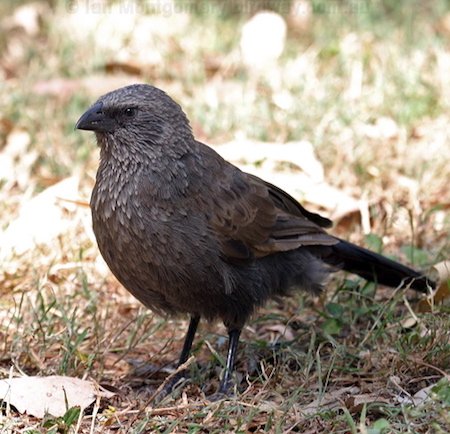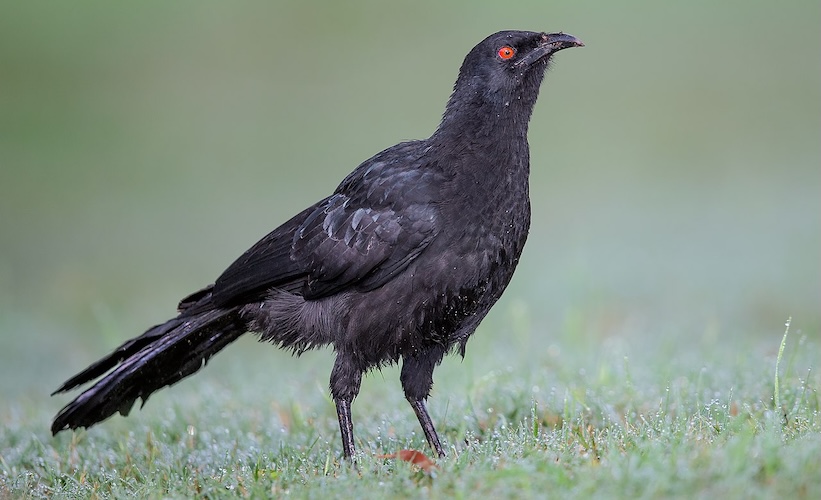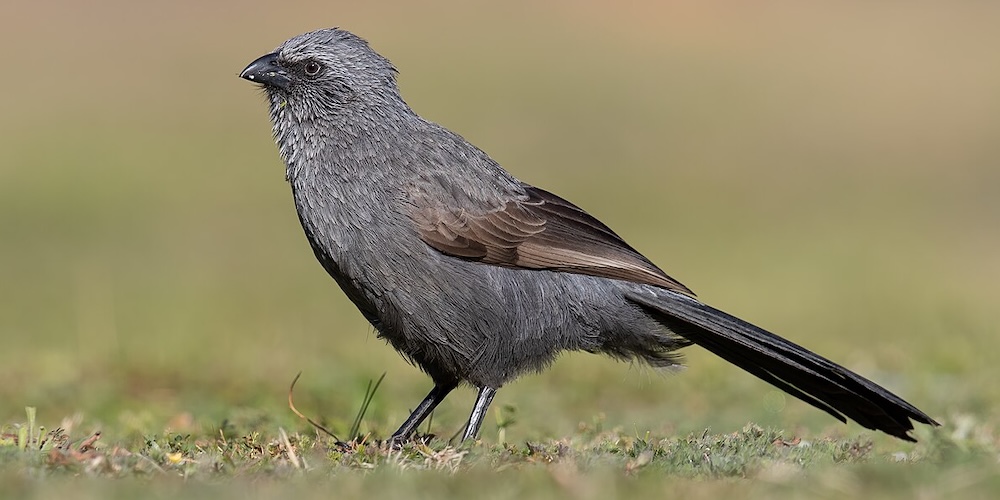Corcoracidae – Australian Mudnesters

Corcoracidae is a family of passerines commonly known as the Australian mudnesters. The family has sometimes been called Struthideidae in the past; however, despite Struthideidae being an older name than Corcoracidae, the latter name takes precedence. It contains just two species in two genera, the White-winged Chough Corcorax melanorhamphos and the Apostlebird Struthidea cinerea. Both are endemic to Australia.
Both are found in open habitat in eastern Australia, mostly open eucalypt woodlands and some forest that lacks a closed canopy. The Apostlebird is more tolerant of arid habitats and is found in arid woodland and shrublands. Both species are tolerant of human modified habitats and will occupy farmlands and suburban areas, and even parks and gardens.

White-winged Chough Corcorax melanorhamphos – ©JJ Harrison CC BY-SA 4.0 via Wikimedia Commons
The two species are medium-sized passerines, the Apostlebird being smaller at around 31 centimetres in length and the larger White-winged Chough averaging 47 centimetres. Their morphology is typical of ground feeding passerines; long feathered legs and short, rounded wings. The most noticeable differences between the two species are in the plumage, which is generally dull, and in the bill. The bill of the Apostlebird is short and deep, not unlike that of a finch, whereas the bill of the White-winged Chough is long and curved, not unlike that of its Old-World namesakes, the choughs. The differences in the bills reflect the differences in feeding, with the Apostlebirds using theirs for sparrow-like picking whereas the White-winged Chough uses its bill to flick leaf litter around.
The social groups of mudnesters are based around a dominant male and female. The number of birds in the group may vary from two to twenty birds, six birds being typical in the White-winged Chough and seven to nine birds in the Apostlebird. Both species are non-migratory and defend a territory during the breeding season. The size of the territory during the breeding season is around 20 ha, after the breeding season when the chicks are fledged the group may range over a larger territory. On the death of one of the dominant breeders the groups break up, and the remaining dominant bird will take immatures from their group and find a lone bird to form a new group. The majority of recruits into any group after its establishment are youngsters from previous breeding seasons. These helpers are important in breeding success, so much so that White-winged Choughs have been reported to kidnap nearly fledged chicks from other groups in order to increase the size of the kidnapping group.

Apostlebird Struthidea cinerea – ©JJ Harrison CC BY-SA 4.0 via Wikimedia Commons
As the common name of the family suggests, the nests are constructed out of mud. These bowl-shaped nests take several days to construct, longer if supplies of mud dry up before the nest is finished. nests are built opportunistically when rain causes muddy puddles, and may be reused if possible. Around three to five oval eggs are laid in each clutch. These eggs are incubated for around twenty days by all members of the group, and feeding and brooding duties are also shared by both parents in both species. This family has a very long period of fledgling care, with full independence from the parents and helpers taking up to 200 days.
In the field, the relationship between the two species is immediately apparent: both species are highly social, spend much of their time foraging through leaf litter with a very distinctive gait, calling to one another almost constantly, and both species respond to a human interloper by flying heavily to a nearby tree, where they wait for the disturbance to pass, often perching close together in twos and threes and allopreening. In picnic grounds and parks these birds may become accustomed to humans and become very tame. The social groups of mudnesters are based around a dominant male and female. The number of birds in the group may vary from two to twenty birds, six birds being typical in the White-winged Chough and seven to nine birds in the Apostlebird, although the latter was named as it was often seen in groups of around a dozen birds.
-
Number of bird species: 2
(As at November 2025)
According to the recently (2025) amalgamated AviList, there are just two species, in separate genera in the Corcoracidae family. They are:
White-winged Chough Corcorax melanorhamphos
Apostlebird Struthidea cinerea
-
Corcoracidae
Family AccountThe corcoracids live in relatively open woodland, known in eastern Australia as mallee, from the tropics to the temperate... -
Corcoracidae
Family AccountCorcoracidae is a family of passerine birds known as the Australian mudnesters.
Given that this is a tiny family with just two species in two genera, Fatbirder provides active links below to both species.
-
Apostlebird Struthidea cinerea
Species AccountThe apostlebird (Struthidea cinerea), also known as the grey jumper, lazy jack or cwa bird is a quick-moving, gray or black bird about 13 inches (33 centimetres) long. It is a native to Australia where it roams woodlands, eating insects and seeds at, or near, ground level. Apostlebirds often travel in groups of about 12; for this reason they were named after the Biblical apostles, the twelve chief followers of Jesus Christ... -
Apostlebird Struthidea cinerea
Species AccountThe Apostlebird is a medium-sized dark grey bird with a short strong bill, brown wings and black tail. It is normally seen in groups of six to ten birds, and is usually seen on the ground. It belongs to the group of birds known as 'mud-nesters', the Family Corcoracidae, noted for their communal life style and their bowl nests constructed of mud and plant fibres.... -
Apostlebird Struthidea cinerea
JCU Species AccountThis noisy gregarious bird is commonly found in open woodland areas, although it has been recorded on campus it is very common in drier areas. These ground feeding birds are found in groups of 6 or more, there may even be up to about 100 in a group. Body is grey with some darker flecks, head is grey, wings brownish, the long tail is black. Legs and feet dark grey to black, eyes brown, bill black... -
Apostlebird Struthidea cinerea
Species AccountThe sexes are similar. The adult has a dark gray plumage with pale gray streaks particularly visible on the head, coat, throat and chest. Its wings are brown and long tail feathers of the tail are black with green highlights. The beak robust is black. The legs and feet are blackish. The color of the iris varies with age: in nestlings, they are brown, in immature than a year, they are gray, adults aged at least two years, they are gray with narrow yellow eye ring . This ring becomes wider and more prominent as and as the bird gets older... -
Apostlebird Struthidea cinerea
Species AccountSound archive and distribution maps -
White-winged Chough Corcorax melanorhamphos
Species AccountThe white-winged chough (Corcorax melanorhamphos) is one of only two surviving members of the Australian mud-nest builders family, Corcoracidae, and is the only member of the genus Corcorax. It is native to Southern and Eastern Australia and is an example of convergent evolution as it is only distantly related to the European choughs that it closely resembles in shape, and for which it was named. -
White-winged Chough Corcorax melanorhamphos
Species AccountThe White-winged Chough is a large, almost completely black bird. It has a curved beak, a red eye and a large white wing patch, which is seen when the bird is in flight. The bill and legs are black. Both male and female share the same plumage pattern. Young White-winged Choughs start off duskier than the adults, and the eye is brown. They do not reach sexual maturity until four years of age and, during this time, the eye changes from brown to orange and then to red, and the plumage darken -
White-winged Chough Corcorax melanorhamphos
Species AccountSound archive and distribution maps
